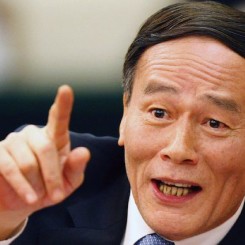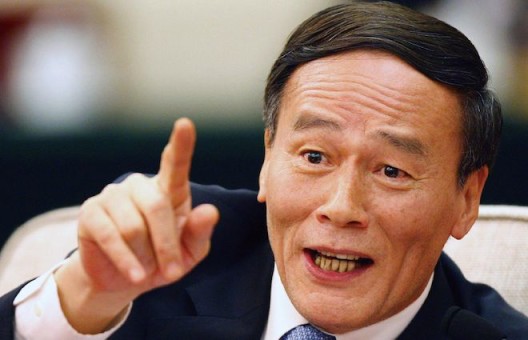Some time after the new year, an emphatic remark by Wang Qishan, China’s top graft-buster and head of the Central Commission for Discipline Inspection (CCDI), at a CCDI group discussion session made the Chinese calligraphy world shudder. He reportedly said, “Some cadres plunge right into running script before they can even handle regular script, and even dare to gift their works.” [link in Chinese; report in NYTimes] (Regular script is the basic style of Chinese calligraphy, while running script and cursive script require more complex techniques). On some local calligraphers associations’ overly close affinity with government officials, Wang noted, “Some officials are indulging themselves so much that they have forgotten the proper relationship between the governing party and the public.” In fact, the “shock” in the calligraphy world started near the end of last year, when an article in People’s Daily in December 2014 accused government officials of “feathering their own nests through their affiliation with calligraphers’ associations…and pushing their way into artists’ associations where they moonlight and make a fortune by way of their power within the associations, and where they find their works of inferior quality hotly sought after.” (Of course, this is because if government officials are bestowed the identity of calligraphers and artists, bribe-payers are able to legitimately bribe them by “collecting” their works, with the sellers and buyers closely guarding and making a secret deal.)
The so-called “calligraphy world” is in fact a contemporary creation, which is regarded, along with the various “artists’ association” (with China Artists Association at the apex), as part of the bureaucratic cultural system. [1] As the official organization of Chinese calligraphers, China Calligraphers’ Association was founded in 1981. Its provincial, municipal and local subsidiaries were subsequently established. In the association’s charter it is clearly stipulated that China Calligraphers’ Association “is a professional organization composed of calligraphers of various ethnic groups from across China under the leadership of the Chinese Communist Party; it serves as the bridge to connect the party and the government with all the calligraphers and practitioners of calligraphy; it is an important force to bring about the prosperity of socialist art and the development of advanced art.” Although calligraphers’ associations nation-wide only have a history of a few decades, there has been a longer cultural history of close integration between calligraphy and the imperial bureaucracy. Since the end of Han Dynasty when the history of aesthetic calligraphy came into being, there had rarely been any pure “calligraphers”—even if there were, they were often closely connected with officialdom. For instance, Wang Xizhi of Six Dynasty period, Mi Fu of the Song Dynasty and Dong Qichang of the Ming Dynasty were all part of the Imperial Court. Besides, some well-known calligraphers in Chinese history were notorious, corrupt, treacherous ministers, notable among them were Cai Jing and Qin Hui. Of course, it was only natural for emperors and rulers of various historical periods to practice calligraphy and become adept at it; after all, the mastery of calligraphy to some extent justified a ruler from a cultural perspective, be it Emperor Hui Zong of the Song Dynasty who created the Slender Golden Script (shoujinti), or the Kangxi and Qianlong emperors—or Mao Zedong. Emperors and rulers excelling at calligraphy became part of the culture. As an extreme example, Emperor Taizong of the Tang Dynasty (born Li Shimin) was so obsessed with the Preface to the Orchid Pavilion (Lantingxu) during his life that he had it buried in his tomb. Ever since then, calligraphy became the mainstream embodiment of successive officials’ mingling with men of letters and posing as lovers of culture; meanwhile, bribing officials in a cultured manner also evolved into an integral part of the bureaucratic culture, spanning over a millennium.
At present, the meaning of “calligraphy” itself becomes ambiguous, beset by a messy, multi-pronged identify of contradictions. Defined as a form of visual art, calligraphy as a field of study has been opened up across colleges and graduate schools (a large number of calligraphy majors spend most of their time figuring out how to integrate their work into the official system). It is still the mark of a cultured Chinese person, and a talent supposedly “naturally” possessed by officials. Its association with someone’s character and integrity is still being extolled (Cai Jing’s expulsion from the “Four Masters of Northern Song Dynasty” had nothing to do with his talent in calligraphy, but everything to do with his character). Due to its role as the face of classical Chinese culture and a symbol of Chinese cultural tradition, calligraphy is understandably regarded as an ideal medium for venal, shady transactions between officials and businessmen as well as among officials themselves—and now, it has directly or indirectly become a target of the recent anti-corruption reforms.
[1] Simply put, in China, the core of “official art” (tizhinei de yishu; “art within the system” or “establishment art”) is composed of China Artists’ Association, China Calligraphers’ Association, National Art Exhibition, various professional art schools, etc. Among these entities, China Artists’ Association and China Calligraphers’ Association have their provincial, municipal and local subsidiaries.




